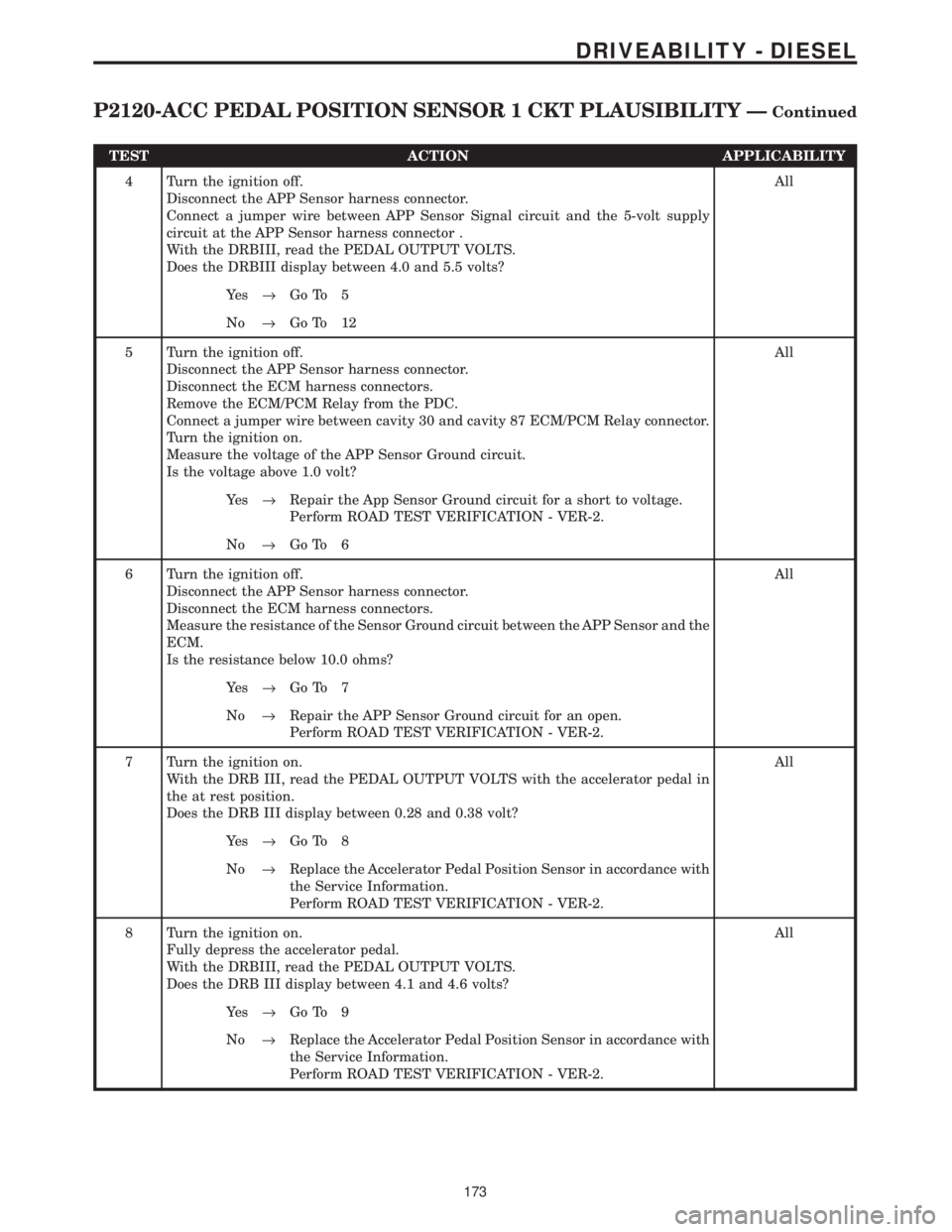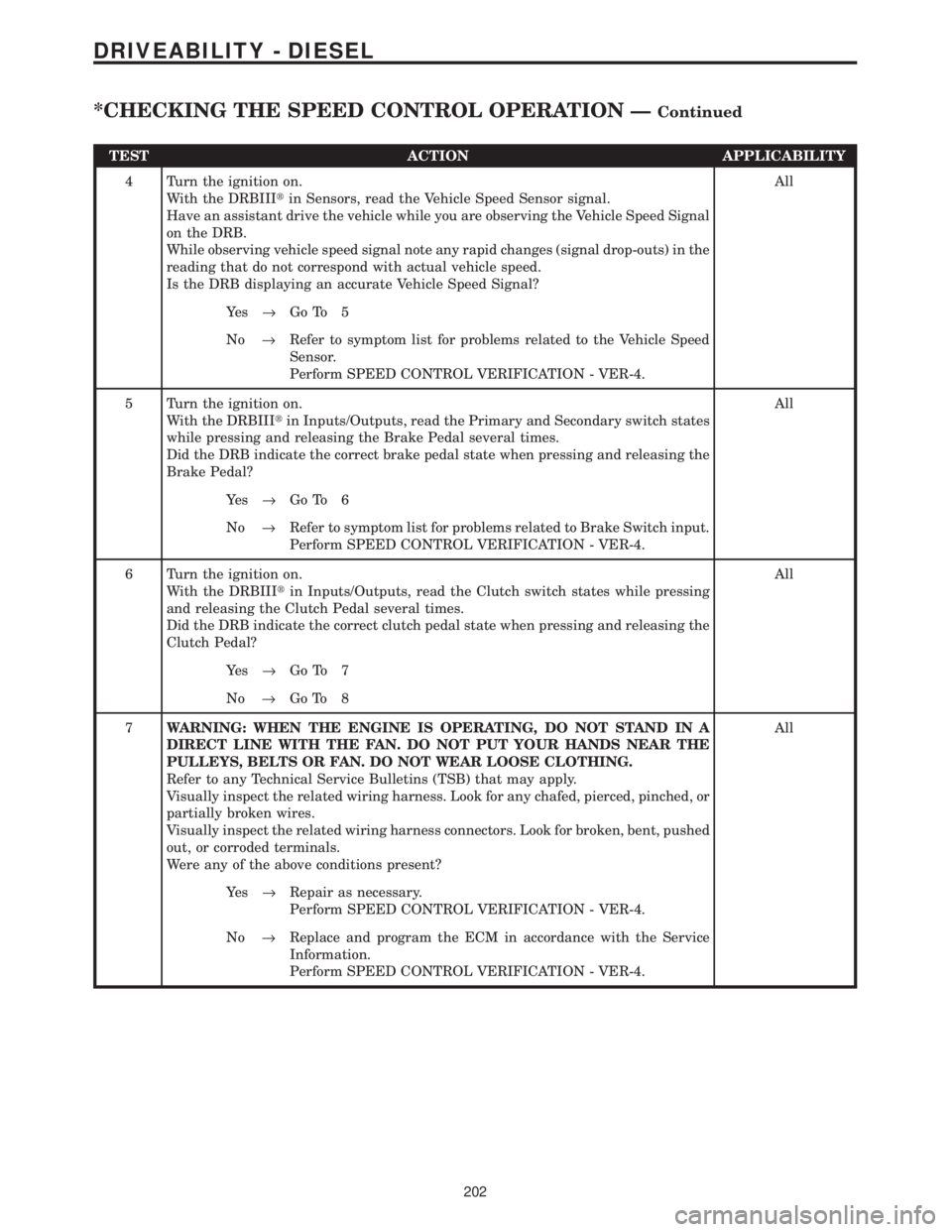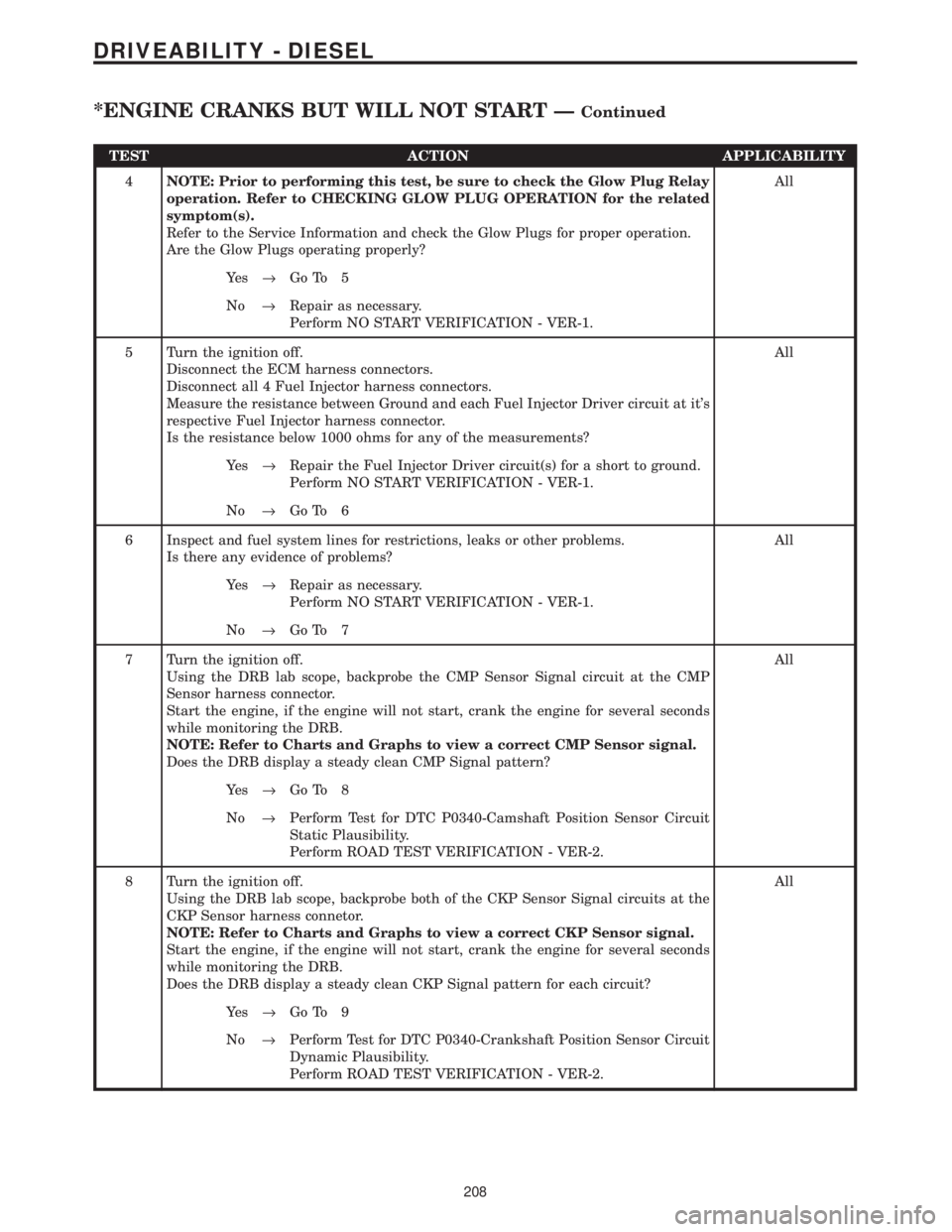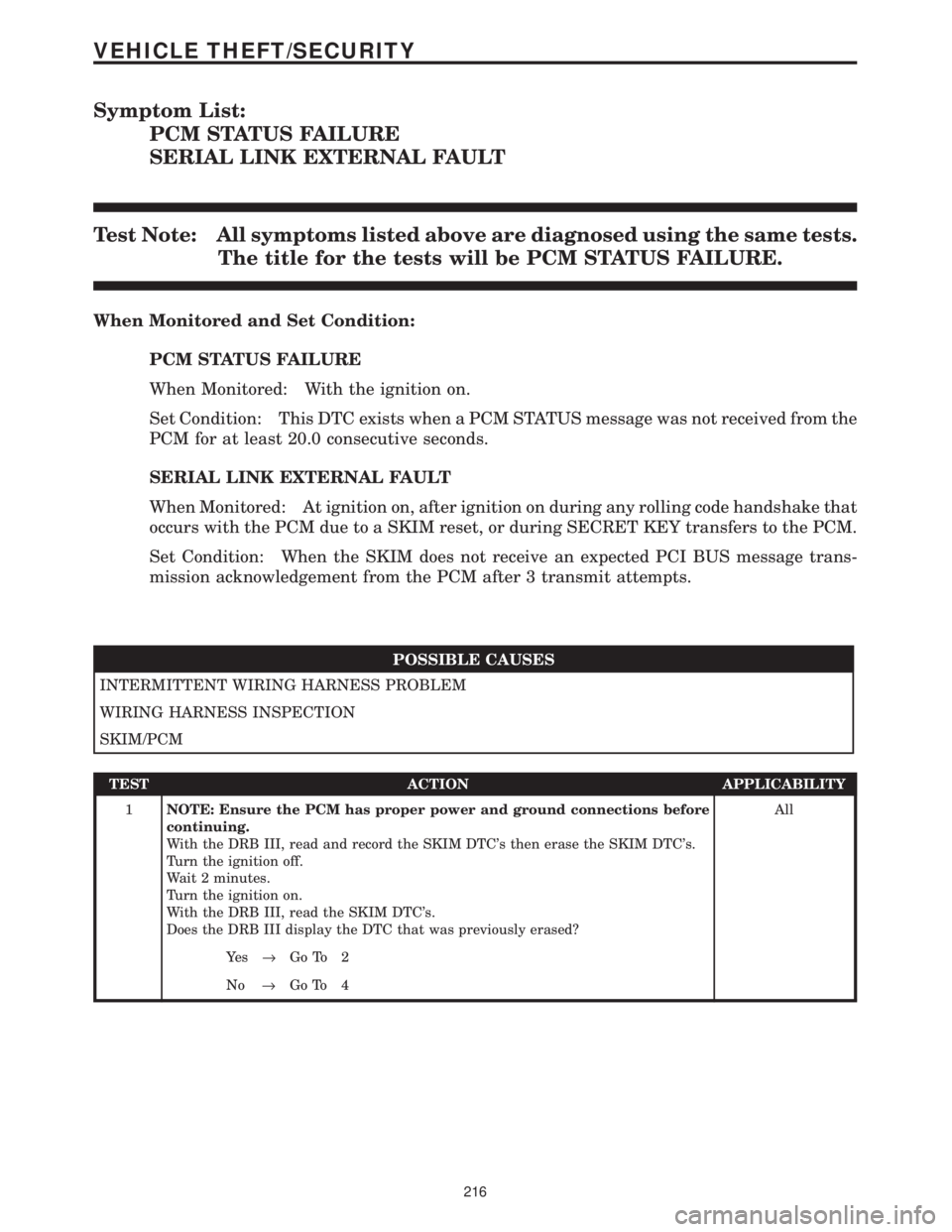display CHRYSLER VOYAGER 2001 Service Manual
[x] Cancel search | Manufacturer: CHRYSLER, Model Year: 2001, Model line: VOYAGER, Model: CHRYSLER VOYAGER 2001Pages: 4284, PDF Size: 83.53 MB
Page 1392 of 4284

TEST ACTION APPLICABILITY
4 Turn the ignition off.
Disconnect the APP Sensor harness connector.
Connect a jumper wire between APP Sensor Signal circuit and the 5-volt supply
circuit at the APP Sensor harness connector .
With the DRBIII, read the PEDAL OUTPUT VOLTS.
Does the DRBIII display between 4.0 and 5.5 volts?All
Ye s®Go To 5
No®Go To 12
5 Turn the ignition off.
Disconnect the APP Sensor harness connector.
Disconnect the ECM harness connectors.
Remove the ECM/PCM Relay from the PDC.
Connect a jumper wire between cavity 30 and cavity 87 ECM/PCM Relay connector.
Turn the ignition on.
Measure the voltage of the APP Sensor Ground circuit.
Is the voltage above 1.0 volt?All
Ye s®Repair the App Sensor Ground circuit for a short to voltage.
Perform ROAD TEST VERIFICATION - VER-2.
No®Go To 6
6 Turn the ignition off.
Disconnect the APP Sensor harness connector.
Disconnect the ECM harness connectors.
Measure the resistance of the Sensor Ground circuit between the APP Sensor and the
ECM.
Is the resistance below 10.0 ohms?All
Ye s®Go To 7
No®Repair the APP Sensor Ground circuit for an open.
Perform ROAD TEST VERIFICATION - VER-2.
7 Turn the ignition on.
With the DRB III, read the PEDAL OUTPUT VOLTS with the accelerator pedal in
the at rest position.
Does the DRB III display between 0.28 and 0.38 volt?All
Ye s®Go To 8
No®Replace the Accelerator Pedal Position Sensor in accordance with
the Service Information.
Perform ROAD TEST VERIFICATION - VER-2.
8 Turn the ignition on.
Fully depress the accelerator pedal.
With the DRBIII, read the PEDAL OUTPUT VOLTS.
Does the DRB III display between 4.1 and 4.6 volts?All
Ye s®Go To 9
No®Replace the Accelerator Pedal Position Sensor in accordance with
the Service Information.
Perform ROAD TEST VERIFICATION - VER-2.
173
DRIVEABILITY - DIESEL
P2120-ACC PEDAL POSITION SENSOR 1 CKT PLAUSIBILITY ÐContinued
Page 1393 of 4284

TEST ACTION APPLICABILITY
9 Turn the ignition on.
With the DRB III, read the PEDAL OUTPUT VOLTS.
With the accelerator pedal in the idle position, slowly depress the accelerator pedal
until the pedal is fully depressed.
NOTE: The PEDAL OUTPUT VOLTS should increase smoothly as the pedal
is depressed.
Does the voltage increase smoothly with the accelerator pedal travel?All
Ye s®Go To 10
No®Replace the Accelerator Pedal Position Sensor in accordance with
the Service Information.
Perform ROAD TEST VERIFICATION - VER-2.
10 Turn the ignition on.
With the DRB III, select Engine and with the custom display feature select Low Idle
Switch input and the Accel Pedal %.
Slowly depress and release the accelerator pedal several times while monitoring the
DRB III display.
NOTE: The Low Idle Switch state should change between 5% and 10% of
Accelerator Pedal position.
Did the Low Idle Switch state change between 5% and 10% of Accelerator Pedal
position?All
Ye s®Go To 11
No®Replace the Accelerator Pedal Position Sensor.
Perform ROAD TEST VERIFICATION - VER-2.
11WARNING: WHEN THE ENGINE IS OPERATING, DO NOT STAND IN A
DIRECT LINE WITH THE FAN. DO NOT PUT YOUR HANDS NEAR THE
PULLEYS, BELTS OR FAN. DO NOT WEAR LOOSE CLOTHING.
NOTE: The conditions that set the DTC are not present at this time. The
following list may help in identifying the intermittent condition.
With the engine running and at normal operating temperature, monitor the DRB
parameters related to the DTC while wiggling the wiring harness. Look for param-
eter values to change and/or a DTC to set.
Review the DTC When Monitored and Set Conditions. If possible, try to duplicate the
conditions under which the DTC was set.
Refer to any Technical Service Bulletins (TSB) that may apply.
Visually inspect the related wiring harness. Look for any chafed, pierced, pinched, or
partially broken wires.
Visually inspect the related wiring harness connectors. Look for broken, bent, pushed
out, or corroded terminals.
Were any of the above conditions present?All
Ye s®Repair as necessary.
Perform ROAD TEST VERIFICATION - VER-2.
No®Test Complete.
12 Turn the ignition off.
Disconnect the APP Sensor harness connector.
Disconnect the ECM harness connectors.
Measure the resistance of the APP Sensor Signal circuit.
Is the resistance below 10.0 ohms?All
Ye s®Go To 13
No®Repair the APP Sensor Signal circuit for an open
Perform ROAD TEST VERIFICATION - VER-2.
174
DRIVEABILITY - DIESEL
P2120-ACC PEDAL POSITION SENSOR 1 CKT PLAUSIBILITY ÐContinued
Page 1421 of 4284

TEST ACTION APPLICABILITY
4 Turn the ignition on.
With the DRBIIItin Sensors, read the Vehicle Speed Sensor signal.
Have an assistant drive the vehicle while you are observing the Vehicle Speed Signal
on the DRB.
While observing vehicle speed signal note any rapid changes (signal drop-outs) in the
reading that do not correspond with actual vehicle speed.
Is the DRB displaying an accurate Vehicle Speed Signal?All
Ye s®Go To 5
No®Refer to symptom list for problems related to the Vehicle Speed
Sensor.
Perform SPEED CONTROL VERIFICATION - VER-4.
5 Turn the ignition on.
With the DRBIIItin Inputs/Outputs, read the Primary and Secondary switch states
while pressing and releasing the Brake Pedal several times.
Did the DRB indicate the correct brake pedal state when pressing and releasing the
Brake Pedal?All
Ye s®Go To 6
No®Refer to symptom list for problems related to Brake Switch input.
Perform SPEED CONTROL VERIFICATION - VER-4.
6 Turn the ignition on.
With the DRBIIItin Inputs/Outputs, read the Clutch switch states while pressing
and releasing the Clutch Pedal several times.
Did the DRB indicate the correct clutch pedal state when pressing and releasing the
Clutch Pedal?All
Ye s®Go To 7
No®Go To 8
7WARNING: WHEN THE ENGINE IS OPERATING, DO NOT STAND IN A
DIRECT LINE WITH THE FAN. DO NOT PUT YOUR HANDS NEAR THE
PULLEYS, BELTS OR FAN. DO NOT WEAR LOOSE CLOTHING.
Refer to any Technical Service Bulletins (TSB) that may apply.
Visually inspect the related wiring harness. Look for any chafed, pierced, pinched, or
partially broken wires.
Visually inspect the related wiring harness connectors. Look for broken, bent, pushed
out, or corroded terminals.
Were any of the above conditions present?All
Ye s®Repair as necessary.
Perform SPEED CONTROL VERIFICATION - VER-4.
No®Replace and program the ECM in accordance with the Service
Information.
Perform SPEED CONTROL VERIFICATION - VER-4.
202
DRIVEABILITY - DIESEL
*CHECKING THE SPEED CONTROL OPERATION ÐContinued
Page 1422 of 4284

TEST ACTION APPLICABILITY
8 Turn the ignition off.
Disconnect the Clutch Pedal Switch harness connector.
Turn the ignition on.
With the DRBIIItin Inputs/Outputs, read the Clutch Switch state while using a
jumper wire to connect the Clutch Pedal Switch Sense circuit to ground at the Clutch
Pedal Switch harness connector.
NOTE: Leave jumper connected to ground for 5 seconds then disconnect
jumper and note DRB reading for both conditions.
Does the DRB display RELEASED and PRESSED?All
Ye s®Replace the Clutch Pedal Switch.
Perform SPEED CONTROL VERIFICATION - VER-4.
No®Go To 9
9 Turn the ignition off.
Disconnect the Clutch Pedal Switch harness connector.
Measure the resistance of the Clutch Pedal Switch Sense circuit.
Is the resistance below 10.0 ohms?All
Ye s®Go To 10
No®Repair the Clutch Pedal Switch Sense circuit for an open.
Perform SPEED CONTROL VERIFICATION - VER-4.
10 Turn the ignition off.
Disconnect the Clutch Pedal Switch harness connector.
Disconnect the ECM harness connectors.
Measure the resistance between ground and the Clutch Pedal Switch Sense circuit.
Is the resistance below 1000 ohms?All
Ye s®Repair the Clutch Pedal Switch Sense circuit for a short to
ground.
Perform SPEED CONTROL VERIFICATION - VER-4.
No®Replace and program the ECM in accordance with the Service
Information.
Perform SPEED CONTROL VERIFICATION - VER-4.
203
DRIVEABILITY - DIESEL
*CHECKING THE SPEED CONTROL OPERATION ÐContinued
Page 1423 of 4284

Symptom:
*CHECKING THE VEHICLE SPEED SIGNAL
POSSIBLE CAUSES
VEHICLE SPEED SENSOR SIGNAL CIRCUIT SHORTED TO SENSOR GROUND
CHECK FOR VSS DTC
IGNITION SWITCH OUTPUT CIRCUIT OPEN
SPEEDOMETER PINION AND DRIVE TEETH DAMAGED
VEHICLE SPEED SENSOR SIGNAL CIRCUIT SHORTED TO GROUND
VEHICLE SPEED SENSOR SIGNAL CIRCUIT SHORTED TO VOLTAGE
ENGINE CONTROL MODULE - SHORTED TO VOLTAGE
VEHICLE SPEED SENSOR SIGNAL CIRCUIT OPEN
SENSOR GROUND CIRCUIT OPEN
VEHICLE SPEED SENSOR
ENGINE CONTROL MODULE - INTERNAL FAULT
TEST ACTION APPLICABILITY
1 Turn the ignition on.
With the DRB, select Engine, then Sensors.
While an assistant is test driving the vehicle, note the Vehicle Speed reading on the
DRB.
While reading the VSS Signal, note any rapid changes (signal drop-outs) that do not
correspond with actual vehicle speed.
Does the DRB display an accurate vehicle speed reading?All
Ye s®Test Complete.
No®Go To 2
2 Turn the ignition on.
With the DRB, read ECM DTCs.
Are any VSS DTCs present?All
Ye s®Refer to symptom list for problems related to VSS DTCs.
Perform ROAD TEST VERIFICATION - VER-2.
No®Go To 3
3 Turn the ignition off.
Remove the Vehicle Speed Sensor.
Inspect the Speedometer Pinion and drive teeth on the Output Shaft (located in the
transmission).
Inspect the VSS for metal debris and damage to the Sensor and connector.
Are both components OK?All
Ye s®Go To 4
No®Repair or replace the Speedometer Pinion or internal components
as necessary in accordance with the Service Information.
Perform ROAD TEST VERIFICATION - VER-2.
204
DRIVEABILITY - DIESEL
Page 1425 of 4284

TEST ACTION APPLICABILITY
9 Turn the ignition off.
Disconnect the ECM harness connectors.
Disconnect the Vehicle Speed Sensor harness connector.
Measure the resistance of the Vehicle Speed Sensor Signal circuit.
Is the resistance below 5.0 ohms?All
Ye s®Go To 10
No®Repair the Vehicle Speed Sensor Signal circuit for an open.
Perform ROAD TEST VERIFICATION - VER-2.
10 Turn the ignition off.
Disconnect the ECM harness connectors.
Disconnect the Vehicle Speed Sensor harness connector.
Measure the resistance of the Vehicle Speed Sensor Ground circuit.
Is the resistance below 5.0 ohms?All
Ye s®Go To 11
No®Repair the Vehicle Speed Sensor Ground circuit for an open.
Perform ROAD TEST VERIFICATION - VER-2.
11 Turn the ignition off.
Disconnect the Vehicle Speed Sensor harness connector.
NOTE: Ensure the ECM harness connectors are connected before continu-
ing.
Turn the ignition on.
Connect a jumper wire to the Vehicle Speed Sensor Signal circuit in the VSS harness
connector.
With the DRB, monitor the VEHICLE SPEED while tapping the other end of the
jumper wire to ground.
Does the DRB display km/h (MPH) greater than 0?All
Ye s®Replace the Vehicle Speed Sensor.
Perform ROAD TEST VERIFICATION - VER-2.
No®Go To 12
12 Turn the ignition off.
Disconnect the Vehicle Speed Sensor harness connector.
Disconnect the ECM harness connectors.
Measure the resistance between the Vehicle Speed Sensor Signal circuit and the
Sensor Ground circuit.
Is the resistance above 100k ohms?All
Ye s®Go To 13
No®Repair the Vehicle Speed Sensor Signal circuit for a short to the
Sensor Ground circuit.
Perform ROAD TEST VERIFICATION - VER-2.
13 If there are no possible causes remaining, view repair. All
Repair
Replace and program the Engine Control Module in accordance
with the Service Information.
Perform ROAD TEST VERIFICATION - VER-2.
206
DRIVEABILITY - DIESEL
*CHECKING THE VEHICLE SPEED SIGNAL ÐContinued
Page 1426 of 4284

Symptom:
*ENGINE CRANKS BUT WILL NOT START
POSSIBLE CAUSES
CHECKING FOR ECM CODES
CHECKING FOR SKIM CODES
CHECKING THE ECT SENSOR
CHECKING THE GLOW PLUG OPERATION
ENGINE DRIVE BELT
FUEL INJECTOR DRIVER CIRCUIT(S) SHORTED TO GROUND
FUEL PRESSURE SENSOR
FUEL PRESSURE SENSOR 5-VOLT SUPPLY CIRCUIT OPEN
FUEL PRESSURE SENSOR SIGNAL CIRCUIT OPEN
FUEL SUPPLY CONTAMINATION
FUEL SYSTEM PRESSURE MECHANICAL
FUEL SYSTEM RESTRICTION
SENSOR GROUND OPEN
TEST ACTION APPLICABILITY
1 Turn the ignition on.
With the DRBIIIt, read the ECM DTCs.
Does the DRBIIItdisplay any ECM DTCs?All
Ye s®Refer to symptom list for problems related to ECM DTC.
Perform NO START VERIFICATION - VER-1.
No®Go To 2
2 Turn the ignition on.
With the DRBIIIt, read the SKIM DTCs.
Does the DRBIIItdisplay any SKIM DTCs?All
Ye s®Refer to symptom list for problems related to SKIM DTC.
Perform NO START VERIFICATION - VER-1.
No®Go To 3
3 Using a temperature probe, check the vehicle temperature near the ECT Sensor.
Turn the ignition on.
With the DRBIIItin Sensors, read the ECT Sensor temperature.
Compare the temperature probe reading with the DRB reading.
Are the two readings within 10ÉC of each other?All
Ye s®Go To 4
No®Repair as necessary.
Perform NO START VERIFICATION - VER-1.
207
DRIVEABILITY - DIESEL
Page 1427 of 4284

TEST ACTION APPLICABILITY
4NOTE: Prior to performing this test, be sure to check the Glow Plug Relay
operation. Refer to CHECKING GLOW PLUG OPERATION for the related
symptom(s).
Refer to the Service Information and check the Glow Plugs for proper operation.
Are the Glow Plugs operating properly?All
Ye s®Go To 5
No®Repair as necessary.
Perform NO START VERIFICATION - VER-1.
5 Turn the ignition off.
Disconnect the ECM harness connectors.
Disconnect all 4 Fuel Injector harness connectors.
Measure the resistance between Ground and each Fuel Injector Driver circuit at it's
respective Fuel Injector harness connector.
Is the resistance below 1000 ohms for any of the measurements?All
Ye s®Repair the Fuel Injector Driver circuit(s) for a short to ground.
Perform NO START VERIFICATION - VER-1.
No®Go To 6
6 Inspect and fuel system lines for restrictions, leaks or other problems.
Is there any evidence of problems?All
Ye s®Repair as necessary.
Perform NO START VERIFICATION - VER-1.
No®Go To 7
7 Turn the ignition off.
Using the DRB lab scope, backprobe the CMP Sensor Signal circuit at the CMP
Sensor harness connector.
Start the engine, if the engine will not start, crank the engine for several seconds
while monitoring the DRB.
NOTE: Refer to Charts and Graphs to view a correct CMP Sensor signal.
Does the DRB display a steady clean CMP Signal pattern?All
Ye s®Go To 8
No®Perform Test for DTC P0340-Camshaft Position Sensor Circuit
Static Plausibility.
Perform ROAD TEST VERIFICATION - VER-2.
8 Turn the ignition off.
Using the DRB lab scope, backprobe both of the CKP Sensor Signal circuits at the
CKP Sensor harness connetor.
NOTE: Refer to Charts and Graphs to view a correct CKP Sensor signal.
Start the engine, if the engine will not start, crank the engine for several seconds
while monitoring the DRB.
Does the DRB display a steady clean CKP Signal pattern for each circuit?All
Ye s®Go To 9
No®Perform Test for DTC P0340-Crankshaft Position Sensor Circuit
Dynamic Plausibility.
Perform ROAD TEST VERIFICATION - VER-2.
208
DRIVEABILITY - DIESEL
*ENGINE CRANKS BUT WILL NOT START ÐContinued
Page 1429 of 4284

Symptom:
*ENGINE WILL NOT CRANK
POSSIBLE CAUSES
BATTERY CABLE HIGH RESISTANCE
CHECKING FOR SKIM CODES
CLUTCH INTERLOCK SWITCH
CLUTCH INTERLOCK SWITCH OUTPUT CIRCUIT
ECM
IGNITION SWITCH START OUTPUT CIRCUIT OPEN
IGNITION SWITCH START OUTPUT CIRCUIT OPEN
INSPECT BATTERY CABLES
MECHANICAL PROBLEM
OPEN FUSED BATTERY (+) CIRCUIT
STARTER MOTOR
STARTER RELAY
STARTER RELAY CONTROL CIRCUIT OPEN
STARTER RELAY CONTROL CIRCUIT SHORTED TO VOLTAGE
STARTER RELAY OUTPUT CIRCUIT OPEN
TEST ACTION APPLICABILITY
1 Turn the ignition off.
NOTE: The battery must be fully charged before diagnosing a no crank
condition.
Inspect the battery cables for corrosion, looseness or other problems.
Is there evidence of problems?All
Ye s®Repair as necessary.
Perform NO START VERIFICATION - VER-1.
No®Go To 2
2 Turn the ignition on.
With the DRBIIIt, read the SKIM DTCs.
Does the DRBIIItdisplay any SKIM DTCs?All
Ye s®Refer to symptom list for problems related to SKIM.
Perform NO START VERIFICATION - VER-1.
No®Go To 3
210
DRIVEABILITY - DIESEL
Page 1435 of 4284

Symptom List:
PCM STATUS FAILURE
SERIAL LINK EXTERNAL FAULT
Test Note: All symptoms listed above are diagnosed using the same tests.
The title for the tests will be PCM STATUS FAILURE.
When Monitored and Set Condition:
PCM STATUS FAILURE
When Monitored: With the ignition on.
Set Condition: This DTC exists when a PCM STATUS message was not received from the
PCM for at least 20.0 consecutive seconds.
SERIAL LINK EXTERNAL FAULT
When Monitored: At ignition on, after ignition on during any rolling code handshake that
occurs with the PCM due to a SKIM reset, or during SECRET KEY transfers to the PCM.
Set Condition: When the SKIM does not receive an expected PCI BUS message trans-
mission acknowledgement from the PCM after 3 transmit attempts.
POSSIBLE CAUSES
INTERMITTENT WIRING HARNESS PROBLEM
WIRING HARNESS INSPECTION
SKIM/PCM
TEST ACTION APPLICABILITY
1NOTE: Ensure the PCM has proper power and ground connections before
continuing.
With the DRB III, read and record the SKIM DTC's then erase the SKIM DTC's.
Turn the ignition off.
Wait 2 minutes.
Turn the ignition on.
With the DRB III, read the SKIM DTC's.
Does the DRB III display the DTC that was previously erased?All
Ye s®Go To 2
No®Go To 4
216
VEHICLE THEFT/SECURITY